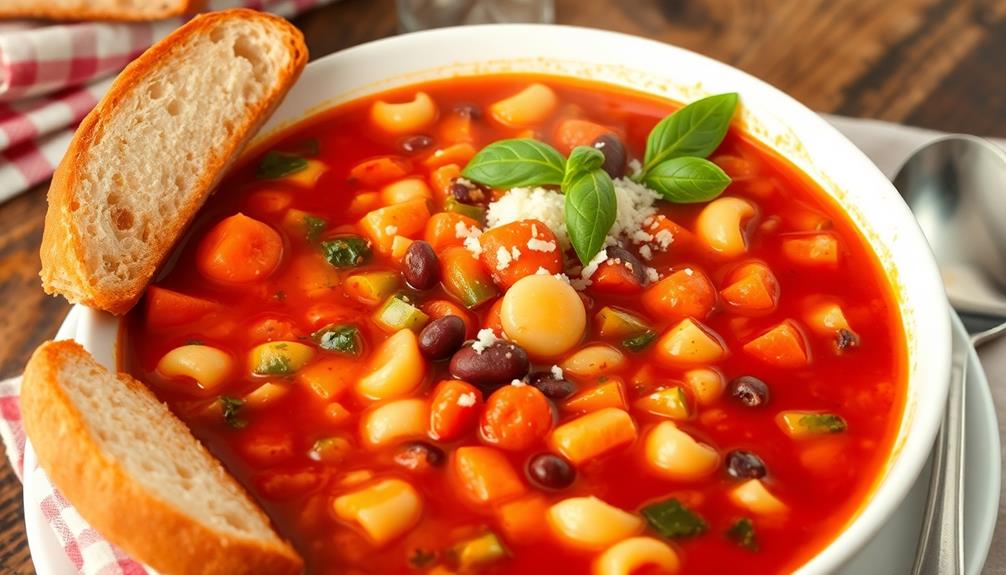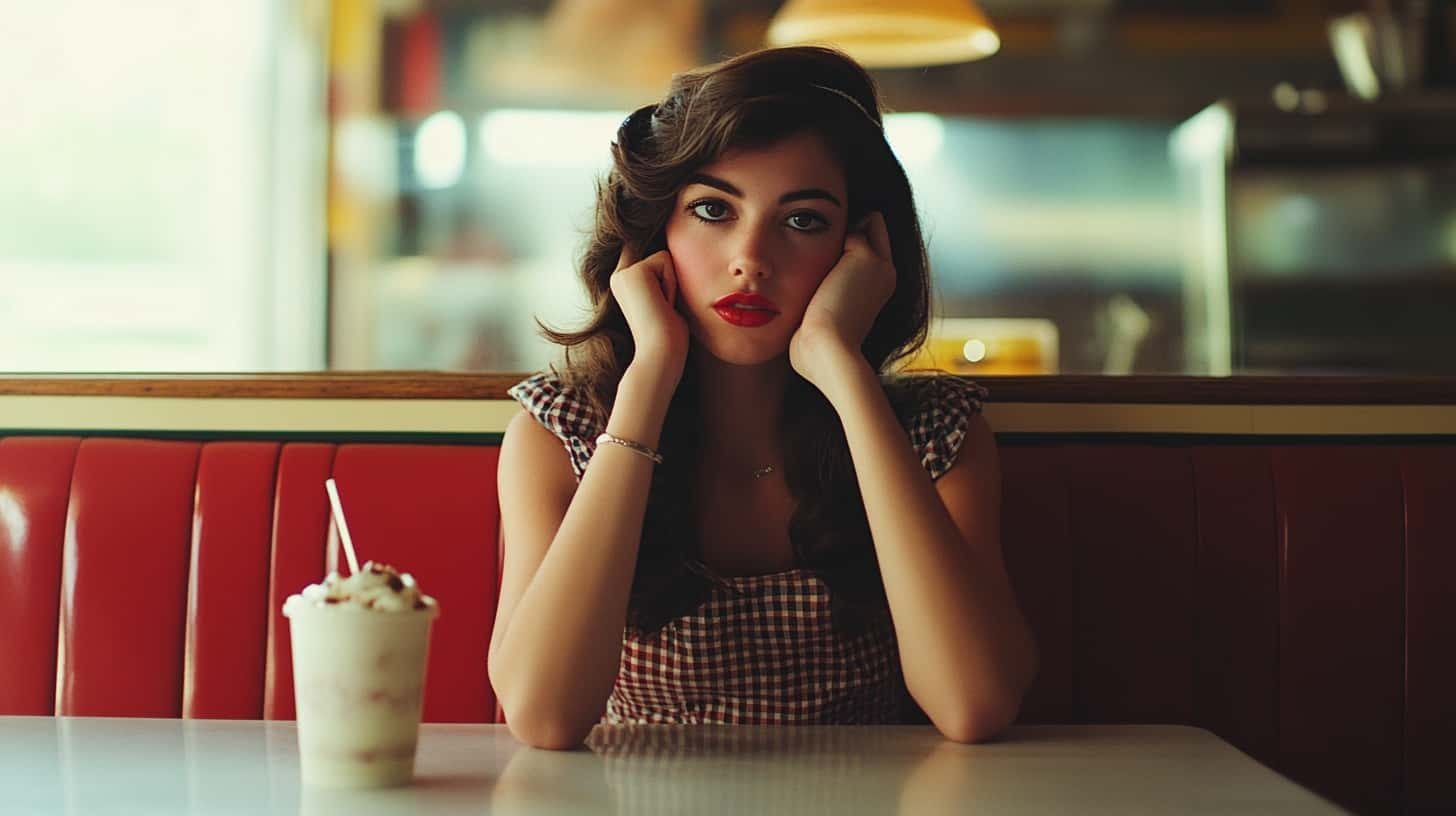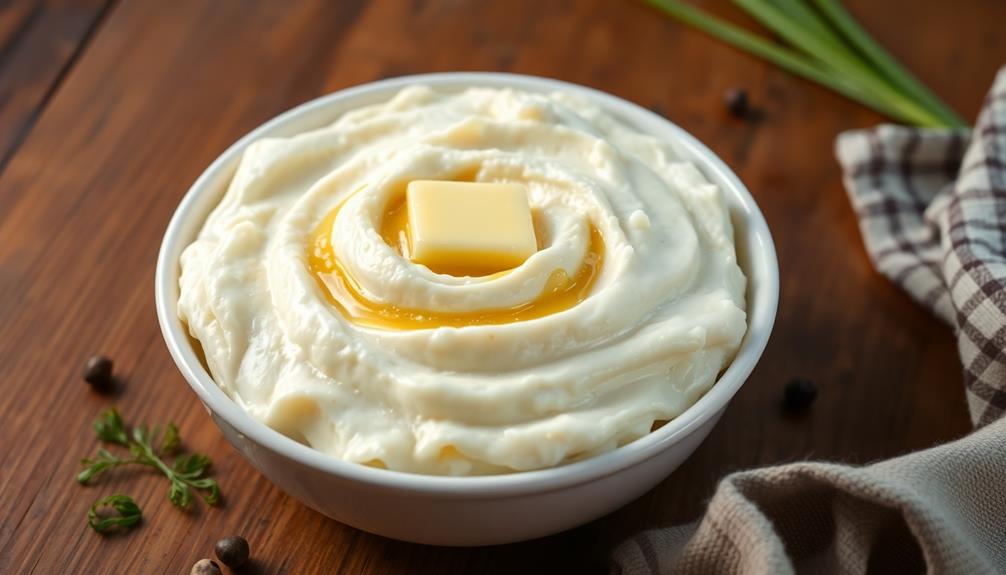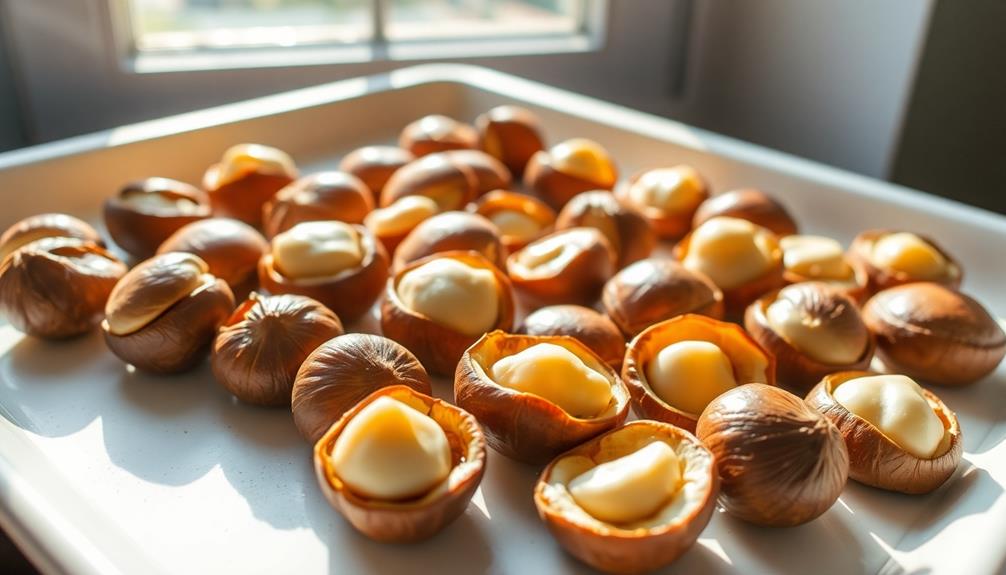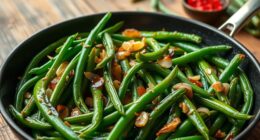Brussels sprouts, once dreaded by many, have become a culinary favorite. These miniature cabbages originated in ancient Rome and gained popularity in Belgium during the 16th century. They're packed with nutrients, including vitamin C and fiber. To prepare them, start by trimming and washing the sprouts, then cut them in half for even cooking. Season with salt and pepper before roasting in a hot oven until golden brown. For an extra flavor boost, drizzle with balsamic glaze before serving. With the right techniques, you'll transform these tiny veggies into a delicious side dish that even skeptics will enjoy. Discover how to elevate your Brussels sprouts game and impress your dinner guests.
Key Takeaways
- Brussels sprouts are nutrient-dense vegetables rich in vitamin C, fiber, and antioxidants.
- They originated in ancient Rome and gained popularity in Belgium during the 16th century.
- Roasting Brussels sprouts at high temperatures enhances their flavor and creates a crispy exterior.
- Seasoning with salt, pepper, and balsamic glaze can transform Brussels sprouts into a delicious side dish.
- Brussels sprouts have evolved from a disliked vegetable to a culinary favorite with proper preparation techniques.
History
Brussels sprouts trace their origins back to ancient Rome, where they were first cultivated from wild cabbage. You might be surprised to learn that these tiny, leafy vegetables have been around for centuries!
As time passed, they made their way through Europe, with Belgium becoming a significant player in their cultivation. In the 16th century, Brussels sprouts gained popularity in Belgium, particularly in the area around Brussels. That's where they got their name!
You'll find that they were grown extensively in the cool climate of the Low Countries, which was perfect for these hardy little veggies. By the 18th century, Brussels sprouts had spread to other parts of Europe and eventually made their way to North America. They've been a staple in many cuisines ever since.
You'll often see them featured in holiday meals, especially in the United States and the United Kingdom. Today, you can find Brussels sprouts grown all over the world, from California to the Netherlands. They've come a long way from their humble beginnings in ancient Rome! In recent years, Brussels sprouts have experienced a resurgence in popularity due to their versatility and health benefits. They can be roasted, sautéed, or even shredded and used in salads. Some people even incorporate them into unique recipes, such as a creamy scalloped potato recipe for added texture and flavor. No matter how you choose to enjoy them, Brussels sprouts are a delicious and nutritious addition to any meal.
Recipe
Brussels sprouts, those miniature cabbage-like vegetables, have undergone a culinary renaissance in recent years. Once maligned as a bitter and unpalatable side dish, they've now become a trendy and beloved ingredient in many kitchens. This recipe will showcase Brussels sprouts in a simple yet delicious preparation that brings out their natural flavors and textures.
Roasting Brussels sprouts is an excellent way to enhance their taste and create a crispy exterior while maintaining a tender interior. The addition of balsamic vinegar and honey in this recipe provides a perfect balance of tangy sweetness that complements the slightly nutty flavor of the sprouts. This dish isn't only flavorful but also nutritious, making it an ideal side for various main courses or even as a standalone vegetarian meal.
- 1 pound Brussels sprouts
- 2 tablespoons olive oil
- 2 tablespoons balsamic vinegar
- 1 tablespoon honey
- Salt and pepper to taste
- 1/4 cup grated Parmesan cheese (optional)
Preheat your oven to 400°F (200°C). Trim the ends of the Brussels sprouts and remove any yellow or damaged outer leaves. Cut them in half lengthwise.
In a large bowl, whisk together olive oil, balsamic vinegar, and honey. Add the Brussels sprouts to the bowl and toss to coat evenly. Spread the sprouts on a baking sheet in a single layer, cut side down. Sprinkle with salt and pepper.
Roast in the preheated oven for 20-25 minutes, or until the sprouts are tender and caramelized, flipping them halfway through cooking. Remove from the oven and sprinkle with grated Parmesan cheese if desired. Serve immediately.
For the best results, choose Brussels sprouts that are similar in size to ensure even cooking. If you prefer a stronger flavor, try adding minced garlic or red pepper flakes to the oil mixture before roasting.
To make this dish vegan-friendly, simply omit the Parmesan cheese or replace it with nutritional yeast. Leftover roasted Brussels sprouts can be stored in an airtight container in the refrigerator for up to 3 days and reheated in the oven or microwave.
Cooking Steps
To cook Brussels sprouts perfectly, you'll want to follow a few key steps.
Start by trimming and washing your sprouts, then cut them in half to ensure even cooking.
Once prepared, season them with salt and pepper before roasting in a hot oven, and finish by drizzling them with a tangy balsamic glaze for an extra burst of flavor.
Step 1. Trim and Wash Sprouts
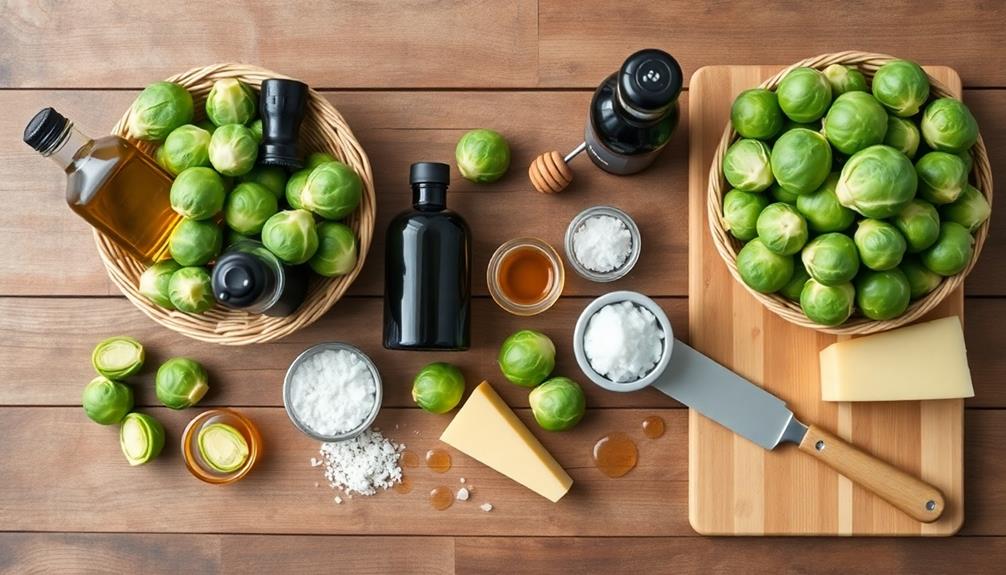
Preparing Brussels sprouts for cooking begins with proper cleaning and trimming. You'll want to start by examining your sprouts and removing any discolored or damaged outer leaves.
Next, rinse them thoroughly under cool running water to remove any dirt or debris that might be clinging to the surface.
Once your sprouts are clean, it's time to trim them. Using a sharp knife, cut off the tough stem end of each sprout, taking care not to remove too much and cause the leaves to fall apart.
If you're working with larger sprouts, you may want to cut an "X" into the base of the stem to help them cook more evenly.
For recipes that call for halved or quartered sprouts, simply cut them lengthwise through the stem. This not only makes them easier to cook but also allows seasonings to penetrate more deeply.
Remember, uniform sizing is key to ensuring all your sprouts cook at the same rate.
Step 2. Cut Sprouts in Half
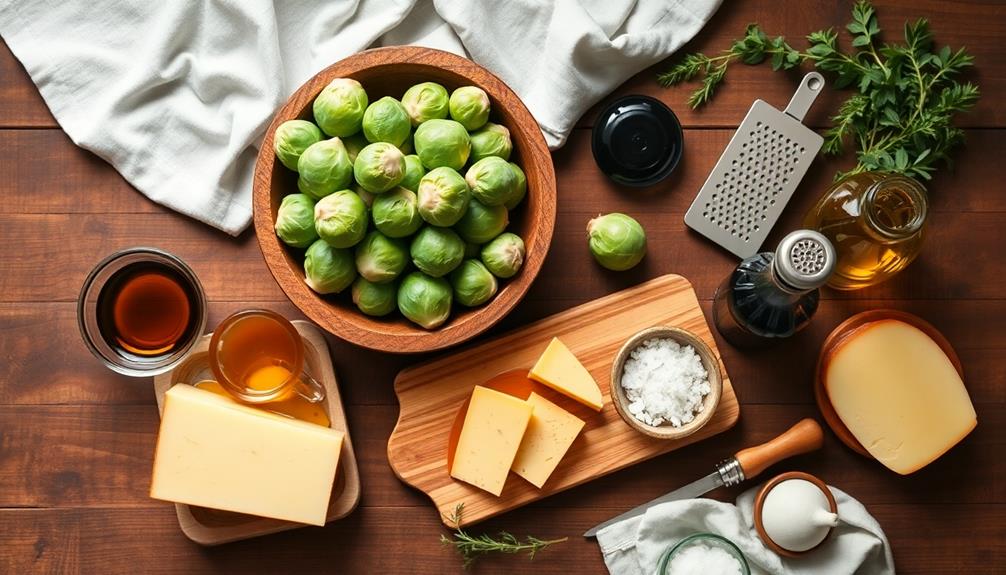
With your Brussels sprouts trimmed and washed, it's time to cut them in half. This step is crucial for achieving the perfect texture and flavor in your dish. Here's why cutting your sprouts matters:
- Even cooking: Halved sprouts cook more evenly, ensuring that both the exterior and interior reach the desired doneness.
- Caramelization: The flat surface created by cutting allows for better contact with the pan, resulting in delicious caramelization.
- Flavor absorption: The exposed interior of the sprout can better absorb seasonings and marinades.
To cut your sprouts in half:
- Place a sprout on your cutting board, stem side down.
- Hold it steady with your non-dominant hand.
- Using a sharp knife, carefully slice through the center of the sprout from top to bottom.
- Repeat with the remaining sprouts.
For larger sprouts, you may want to quarter them to ensure they cook at the same rate as smaller ones.
Step 3. Season With Salt and Pepper

Seasoning your Brussels sprouts with salt and pepper is a crucial step that can't be overlooked. This simple yet essential process enhances the natural flavors of the sprouts, elevating them from bland to delicious.
After you've cut your sprouts in half, it's time to add some seasoning. Start by sprinkling a generous pinch of salt over your halved Brussels sprouts. Don't be shy – salt helps to draw out moisture and intensify the sprouts' inherent sweetness.
Next, add freshly ground black pepper to taste. The peppercorns' sharp, spicy notes complement the sprouts' earthy flavor profile perfectly.
For best results, follow these tips:
- Use kosher or sea salt instead of table salt for better flavor distribution
- Opt for freshly ground black pepper rather than pre-ground for maximum aroma and taste
- Season from about 10 inches above the sprouts to ensure even coverage
- Toss the sprouts gently after seasoning to coat them thoroughly
Step 4. Roast in Hot Oven
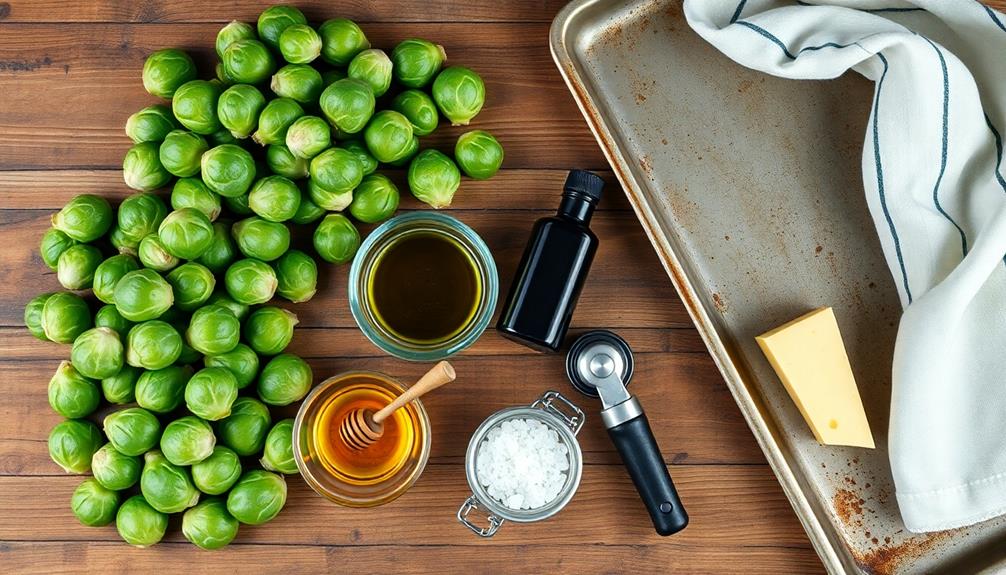
Now that your Brussels sprouts are perfectly seasoned, it's time to roast them to crispy perfection. Preheat your oven to 425°F (220°C) to ensure a hot environment for optimal caramelization.
Spread the seasoned sprouts in a single layer on a baking sheet, making sure they're not overcrowded. This allows hot air to circulate freely, promoting even cooking and browning.
Place the baking sheet in the preheated oven and roast for 20-25 minutes. You'll want to give the sprouts a good shake or stir about halfway through the cooking time to ensure they brown evenly on all sides.
Keep an eye on them as they near the end of cooking, as oven temperatures can vary. You'll know your Brussels sprouts are done when they're tender on the inside and crispy and golden brown on the outside.
The outer leaves should be slightly charred, adding a delicious smoky flavor to the dish. Once they're roasted to your liking, remove them from the oven and let them cool for a few minutes before serving.
This brief rest allows the flavors to settle and makes them easier to handle.
Step 5. Drizzle With Balsamic Glaze
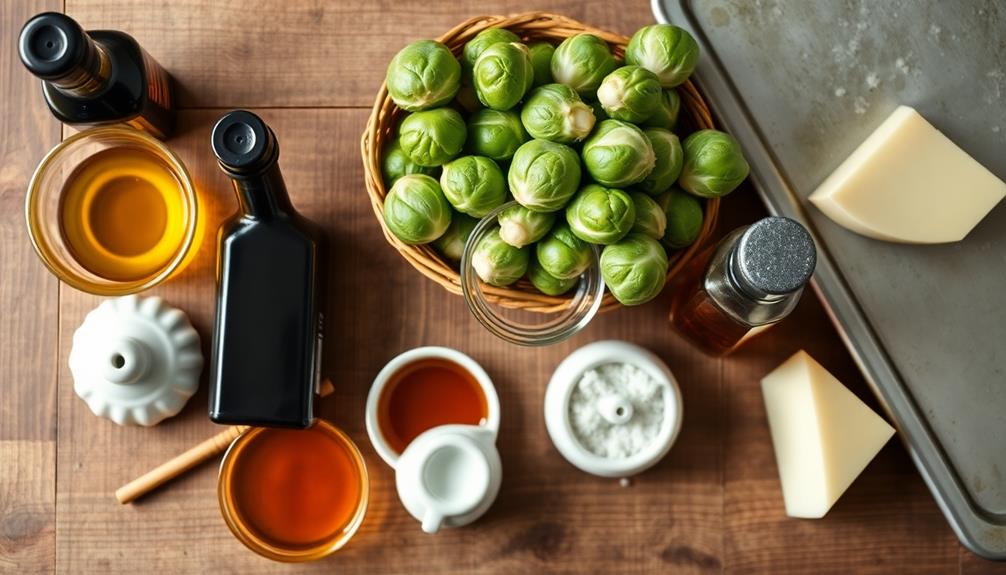
To elevate your roasted Brussels sprouts even further, a drizzle of balsamic glaze adds a perfect finishing touch. This sweet and tangy reduction complements the nutty flavor of the sprouts, creating a delicious balance that'll have you coming back for more.
Here's how to make and apply the glaze:
- In a small saucepan, combine 1 cup of balsamic vinegar with 2 tablespoons of honey.
- Bring the mixture to a boil, then reduce heat and simmer for about 15 minutes.
- Stir occasionally until the liquid has reduced by half and coats the back of a spoon.
- Let it cool slightly – it'll thicken as it cools.
Once your Brussels sprouts are roasted to perfection, transfer them to a serving dish. Drizzle the warm balsamic glaze over the sprouts, making sure to coat them evenly.
The dark, syrupy glaze will create a beautiful contrast against the golden-brown sprouts.
For an extra touch, you can sprinkle some toasted pine nuts or crumbled goat cheese on top. The combination of flavors and textures will make your Brussels sprouts irresistible, even to those who typically shy away from this vegetable.
Final Thoughts
Brussels sprouts have come a long way from their reputation as a dreaded vegetable. With the right preparation techniques and recipes, you'll find that these little green gems can be a delightful addition to your meals.
Remember, the key to enjoying Brussels sprouts lies in how you cook them. Roasting brings out their natural sweetness, while pan-searing creates a crispy exterior.
Don't be afraid to experiment with different seasonings and flavor combinations. From garlic and parmesan to bacon and maple syrup, there's a Brussels sprout recipe out there for everyone.
If you're still hesitant, try incorporating them into dishes you already enjoy, like stir-fries or pasta.
As you've learned, Brussels sprouts aren't only tasty but also packed with nutrients. They're an excellent source of vitamin C, fiber, and antioxidants.
Frequently Asked Questions
Are Brussels Sprouts Actually From Brussels?
You might be surprised to learn that Brussels sprouts aren't actually from Brussels!
They're named after the Belgian capital, but their true origin lies in ancient Rome.
These mini cabbages were likely cultivated in Belgium in the 16th century, which led to their popular name.
Today, they're grown in many countries worldwide.
Can You Eat Brussels Sprouts Raw?
Yes, you can eat Brussels sprouts raw! They're surprisingly versatile and make a crunchy addition to salads or slaws.
To enjoy them uncooked, slice them thinly or shred them for the best texture. Raw Brussels sprouts have a slightly bitter, nutty flavor that's milder than when cooked.
They're packed with nutrients, including vitamins C and K. However, if you have digestive sensitivities, you might find them easier to digest when lightly cooked.
Give raw Brussels sprouts a try and see how you like them!
How Long Do Brussels Sprouts Last in the Refrigerator?
When you're storing fresh brussels sprouts in your fridge, you can expect them to last about 3 to 5 days.
To maximize their shelf life, keep them unwashed in a plastic bag in your crisper drawer. If you've bought them on the stalk, they'll stay fresh for up to a week.
Are Brussels Sprouts and Cabbage the Same Vegetable?
No, Brussels sprouts and cabbage aren't the same vegetable, but they're close relatives.
They're both members of the Brassica family, which includes other veggies like broccoli and kale.
While cabbage forms a large head, Brussels sprouts grow as small, individual buds along a thick stalk.
You'll notice they've similar flavors, but Brussels sprouts are typically more compact and have a slightly nuttier taste.
Both are nutritious choices for your diet, packed with vitamins and fiber.
Do Brussels Sprouts Help With Weight Loss?
Do brussels sprouts help with weight loss? Yes, they can be a great addition to your weight loss journey!
They're low in calories but high in fiber, which helps you feel full longer. You'll also get a nutrient boost, as they're packed with vitamins and minerals.
Try roasting them with a bit of olive oil for a delicious, weight-friendly side dish.

